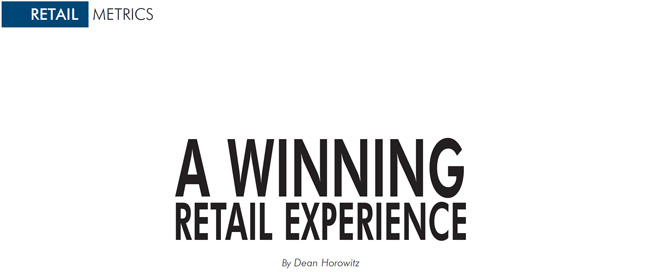
How your store can create a winning retail experience that turns your customers into promoters.
Today, more than ever before, customer experiences will make or break your retail future. Online reviews, omnichannel shopping options, employee turnover, and competition small and large are all threats to your business.
While the burgeoning trend for online retailers to launch brick and mortar stores in selected areas may feel like a win for those of us who appreciate traditional retailing, the data sets online retailers have already collected about retail customers represents a new type of threat. Aside from any economies of scale online giants may possess, they may already know more about your customers and your trading area than you do.
What They Already Know
They posses detailed demographic profiles of your customers and know what your customers' neighbors have purchased or are viewing online. Plus, they have data on credit ratings and behaviors. They may also have identified their inner circles of friends, approaching life events, and some even know when they are 'expecting' before a partner or spouse. And here is one other important piece of information. As a requirement for their online business, these retailers have been obsessed with providing great online service. They employ services to identify “negative reviews” and quickly turn them into endorsements. Access to all this information means they will market to consumers who have the highest propensity to buy from them. They will tailor product selections shown to each prospective customer to match other home furnishings already in their homes, at a price – or other trigger point – that delivers a buying decision.
Survey Results
An April 2019 study, conducted by Sibyl Surveys by Signet Research, asked Furniture World Magazine subscribers to name the "The various ways you/your company currently interacts with your customers." The most common reported interaction at 93.2 percent was in the retail location, followed by 78.4 percent on the phone, 55.4 percent via an ecommerce transaction, 43.2 percent at an event, and 33.8 percent through an interior designer.
“The theory is
that one simple 0-10 rating question can determine if a customer
will be a promoter (9, 10) or a detractor (0-6). ”
Trust & Revenue
- 92 percent of consumers believe suggestions from friends and family more than advertising (Source: Nielsen Report, 2019).
- 88 percent of consumers trust online reviews written by other consumers as much as they trust recommendations from personal contacts (Source: Nielsen Report, 2019).
- Leaders in customer experience deliver, on average, 6x the revenue growth of companies with poorer customer experience (Source, Forrester, 2018)
- A totally satisfied customer contributes six times as much revenue as a somewhat satisfied customer – and 14 times as much revenue as a somewhat dissatisfied customer. (Source: Infoquest, 2019)
- 50 percent of current customers are more likely to try new products and spend 31 percent more on average when compared to a new customer. (Harvard Business Review)
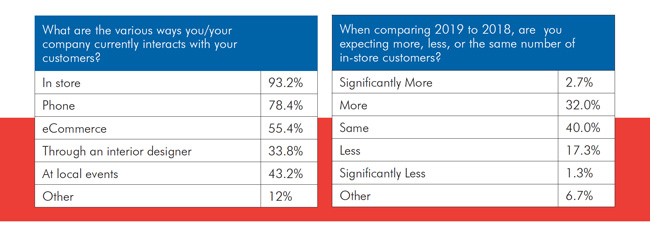
Every Single Touch-point
This means every single touch-point will define your potential for ongoing success.
According to Bain & Company, it costs seven times more to gain a new customer through advertising, outreach, etc., than it does to maintain an existing one. Think about the amount you are currently spending on gaining customer traffic. According to your furniture retailing peers in the survey:
- 79 percent of them are currently investing in their websites.
- 68 percent on print advertising.
- 56 percent on emails.
- 51 percent on digital advertising.
- 48 percent on Local Sponsorships.
- 47 percent on holiday sales.
- 41 percent on local television.
When we consider the actual costs involved with new customer acquisition, these marketing and sales areas are only one factor. Others are, additional costs for personnel, services, office, and technology. It is expensive to gain a new customer.
“People will forget what you said. People will forget what you did. But people will never forget how you made them feel”, is an applicable quote from Maya Angelou. Making them feel great is your edge against all threats to your business. It will ensure that your customer base and revenue continues to grow.
Likewise, the possibility for anyone to have a negative experience with your brand and then effortlessly broadcast it to friends, family, and other potential customers while they are in your store is high. One YouTube video headlined “Don’t buy there!” has more than 33,500 views with comments such as “Thanks for sharing. Saved me a headache. I was about to purchase from….,” and “Same problems I had with this company… BAD FURNITURE.” Yelp, Google Reviews, Facebook, Twitter, Instagram, and others provide an immediate bullhorn to your marketplace.
While Jordan’s Furniture may be known for over-the-top experiences, the mission of Jordan’s is not limited to in store experiences. Their mission encompasses every customer interaction. You do not have to have a ripline or omnimax movie theater to learn from them.
Identifying Problem Areas
Okay, so how do you know if a shopper is having a great brand experience? You can welcome them into your store, treat them kindly, answer the phone with a smile, add a café and fun kids area, but you will still not know. Have you ever been served a terrible meal at a restaurant, only to tell the manager who checked on you that everything was fine? Your customers are most likely answering in the same manner.
Using Net Promoter Scores
|
“56 percent of surveyed retailers are either not familiar with NPS or
aren’t sure they know what it is.” |
About 15 years ago, Fred Reichheld of Bain & Company wrote an excellent article in the Harvard Business Review, “The One Number You Need To Grow”. This one number has transformed businesses since. It is called a Net Promoter Score.” The theory is that one simple 0-10 rating question can determine if a customer will be a promoter (9, 10) or a detractor (0-6). The NPS is determined by subtracting the percentage of promoters from the percentage of detractors. The one simple question is, “Would you recommend Byron’s Furniture to a friend or family member?” can determine immediate actions.
Detractors: If someone is a “detractor” then an email should immediately go out reinforcing their value to your business and desire to correct any issues. A call from a key member of the team should follow.
Promoters: If someone is a “promoter” then here is your opportunity to leverage them to build your customer base. Send them to a public review site. Offer a loyalty program. But, most importantly, identify what made them a promoter and do more of it.
Passives: What if a customer chose a seven or eight? They are called “passives.” These customers are probably going to shop on price or speed of delivery and have no emotional connection to your enterprise. That said, they were satisfied with the experience and are worth nurturing.
The Net Promoter Score is a simple, inexpensive survey tool, yet, according to the recent survey of Furniture World Magazine's furniture retail subscribers, 56 percent of surveyed retailers are either not familiar with NPS or aren’t sure they know what it is. Yet, 41 percent believe that using a Customer Satisfaction surveying tool after a milestone event with a customer will positively impact sales. Sixty-one percent of the retailers surveyed don’t know how to monitor customer satisfaction. Yet, those who do, get satisfaction insights in the following ways:
- 39 percent upon furniture delivery.
- 32 percent at the point of transaction.
- 24 percent via a survey of some kind.
- 17 percent are not conducting any form of customer satisfaction monitoring. Again, the online retailers are doing this 100 percent of the time.
Forty-one percent of retailers stated they believe using a Customer Satisfaction surveying tool after a milestone event with a customer could positively impact sales.
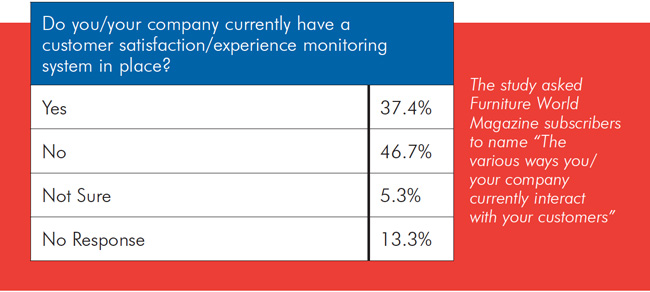
Implementing NPS
How do you institute a customer satisfaction program into your business? According to Byron Zanopoulo, Managing Director of Sibyl Surveys by Signet Research, establishing a customer satisfaction program is a matter of choosing the right platform, about an hour’s worth of training, and then establishing it as a key part of your culture.
“Try to avoid those free, Survey Monkey/Survey Gizmo type platforms. These tools can get you an NPS score, but don’t give you means to segment and analyze those responses efficiently. The dashboard functionality of a well designed CX platform gives you that ability to drill down, and inbox features allow you to respond to each customer’s feedback in a meaningful way. These are key distinguishing characteristics of a valuable CX survey platform.”
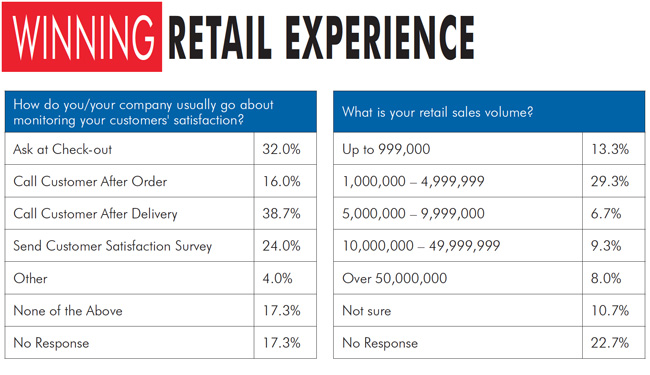
|
“Have you ever been served a terrible meal at a restaurant, only to tell the manager who checked on you that everything was fine? Your customers are most likely answering in the same manner.” |
Key Takeaways
What are the key takeaways?
- It is more profitable to engage a current customer than gain a new one.
- So much focus is on new customers, while instituting a Customer Experience program will be the most effective means to grow your business.
- Anyone who has an interaction with your brand, now has the platform to define who you are and influence others to do business with you.
- Only an on-going “Customer Experience” Feedback Platform will provide you actionable means to turn detractors into promoters.
- Promoters will grow your business and advocate for your growth despite the many threats this world brings.
As ecommerce companies continue to expand, conventional furnishings retailers need to find ways to compete on an even playing field. Identifying your Promoter, Passive and Detractor customers, then taking appropriate action, will help your furniture business to thrive.
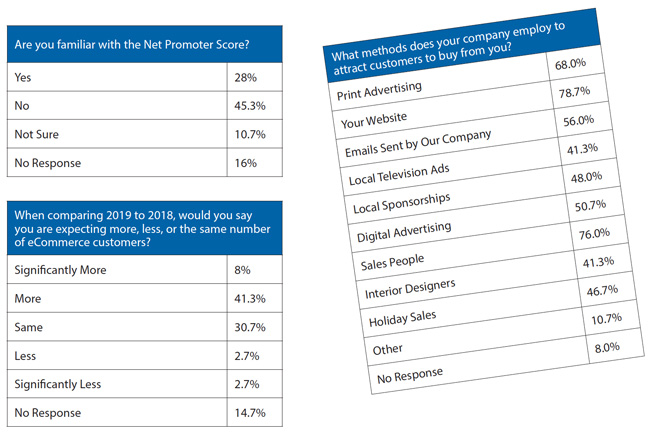
About Dean Horowitz: Dean Horowitz is the co-founder of IdeaSoil and has held leadership roles at b2b and b2c media organizations for more than two decades. His recent focuses have included the home furnishings industry as well as customer experience monitoring tools. He is a Rutgers University graduate who is recognized as a thought leader in the media and marketing space. Questions can be directed to Dean Horowitz at Dean@IdeaSoil.com or 847-922-5102.
About Sibyl Surveys: Sibyl Surveys by Signet Research was developed by a 50+ year old, highly regarded research company as a means for associations to keep and grow membership. The platform expanded its client -base more recently to include furniture retailers seeking to enhance long-term relationship with their customers.
Sibyl offers a Quadrant Report that graphically presents the areas of retail businesses that customers find most satisfying and important. Other useful management reports are available from Sibyl Surveys that provide detailed customer insight. For more information on Sibyl Surveys by Signet Research, contact Byron Zanopoulo at Byron@SignetResearch.com or
201-945-6903.
Furniture World is the oldest, continuously published trade publication in the United States. It is published for the benefit of furniture retail executives. Print circulation of 20,000 is directed primarily to furniture retailers in the US and Canada. In 1970, the magazine established and endowed the Bernice Bienenstock Furniture Library (www.furniturelibrary.com) in High Point, NC, now a public foundation containing more than 5,000 books on furniture and design dating from 1620. For more information contact editor@furninfo.com.